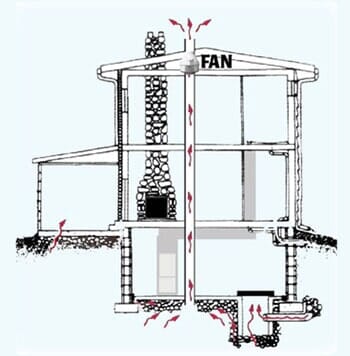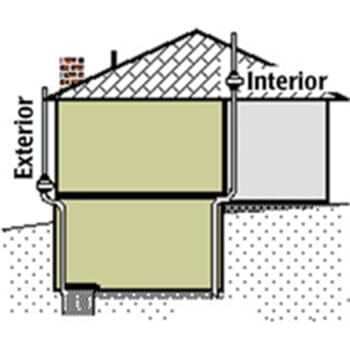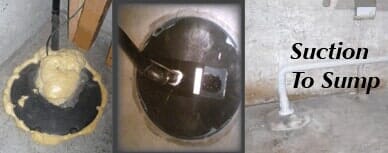The Most Experienced Radon Mitigation Specialists in Kansas City
This first requires an understanding of
RADON ENTRY
RADON ENTRY
- Radon gas is constantly released by each soil granule into soil air.
- Air pressures within the home pull soil air (containing radon gas) from below the foundation into living spaces.
This occurs naturally as warm air rising upward in a home creates a somewhat consistent vacuum in the lower regions.
Once in the home, radon gas is diluted somewhat by fresh air that is also naturally pulled in around windows and doors.
The radon gas is then distributed through the home by heating/cooling blower activity or simple mixing of air.

Simple soil is the most common source, yet radon gas can also result from certain crushed stones, stone formations, or other sources under a home that allow radon gas to move freely.
RADON REDUCTION - RADON MITIGATION
- Systems extend a slight vacuum under the home to pull this air away from living spaces and direct it towards the outside.
- Our experience in over 20,000 systems agrees with EPA studies... studies show, when installed carefully, concentrations are typically reduced by 80-99%.

Basic requirements:
- In Kansas, current state law requires that discharge piping be taken above the roof line for discharging radon safely away from the home.
- Fan must be located outside or above occupied spaces.

(i.e. available pipe routes and aesthetic considerations such as location of unfinished areas, visibility from streets, etc.)

Creation of a suction point.

Extensions / Jumpers are often needed.

Examples of pipe extensions / Jumpers

Extensions and sealing of open earth in a crawl space.

Home design dictates system piping, vacuum and air volume needs.
Vacuum strength
needs are dictated by what’s under the home.
Air Volume
needs depend on soil cavities (size or leakage to building or outside).

Multiple slabs and maximizing success.
Radon enters from under all areas with potency usually based upon area size.
Treating 100% of ground contact areas (including garages) will maximize reductions.

If installed properly:
Radon reductions are typically maintained for the life of the fan.
Fans:
The fans move less air than many bathroom fans (typically less than 60 CFM). Continuous operation is required yet inexpensive (similar to a 40-80 watt light bulb)
Fans are designed to allow rain and all other water to pass through to the soil. Rain caps on pipe are not recommended, nor are they allowed by law in Kansas.
Fan Choices:
It is a balance between vacuum pressure needed (based upon sub-slab conditions) and air volume needed (based upon cavity sizes and tightness.
Experience in choosing the best fan is important. Bigger is not better yet too small will result in compromised effectiveness in cold weather. Oversized fans can cause noise, excess energy loss and problems with other building systems such as combustion appliances. Light duty fans require situations where all gaps and openings to soil can be sealed.

Fan Noise:
Most often noise problems are not from the fan, but caused by things the fan or piping touch. Piping must be installed to avoid vibration transfer to wood framing.
For homes built upon tight soil or sand (often older homes), high suction fans may be required and are capable of greater vibration. Choosing a smart fan location becomes important.
Open pipe - No caps
Fans and system piping must allow water to pass through and drop to the soil under the home. Each day (Particularly in Winter), about 1/2 gallon of water condensates within piping and drains to the soil.
The air discharged is typically near 100% relative humidity. Ice and condensate will form on objects the air strikes. Ice can shut down systems with blockage and siding can rot with constant wetness.


Because fans are so quiet, a pressure gauge is required on the piping for easy verification that the fan is operating.

Safe electrical wiring
Codes:
Wiring should not be rendered less safe than as found and added components shall meet current electrical safety codes.
IN ATTIC:
Disconnect by way of cord to outlet installed within 6 feet. No switch in line.
EXTERIOR:
Sturdy conduit between fan and weather-mount electrical switch box.
Fans can usually be wired to most any branch circuit.
General concerns:
- On a shared switched circuit.
- Exterior wire not protected by sturdy conduit.
- Cords run through walls or on exterior.
- No disconnect (plug or switch) within eyesight of the fan.


A barrier between soil and living spaces is needed to effectively create a slight vacuum under the home. However: A substantial leakage area will exist undetectable to the eye regardless of meticulous sealing efforts.
Systems are still effective since soil air is pulled away from living spaces. Sealing of accessible, large openings to soil is typically a required system component.
There is a minor energy penalty when air is pulled out of the home but major renovations to seal small cracks are not justified monetarily. Appropriate fan sizing aids this concern. For small sealed slabs, a very small fan can also be effective for radon reductions, while also maximizing all aspects of energy efficiency.
Sealing Items & Materials:
Sump cover: . . . . . . . . . . . . . . Customized from clear, non-breakable plastic.
Accessible floor-wall joint: Urethane caulking.
Tiny “hair line” cracks: . . . . .Typically not cost effective or meaningful.
Misc. cracks & openings: . . Caulk, expanding foam, mortar (as needed).
Drains that go to soil: . . . . . Air Traps. (a float prevents upward air flow.)
Open Earth: . . . . . . . . . . . . . . Poly sheeting over open earth and secured/sealed to walls.
Sump cover: . . . . . . . . . . . . . . Customized from clear, non-breakable plastic.
Accessible floor-wall joint: Urethane caulking.
Tiny “hair line” cracks: . . . . .Typically not cost effective or meaningful.
Misc. cracks & openings: . . Caulk, expanding foam, mortar (as needed).
Drains that go to soil: . . . . . Air Traps. (a float prevents upward air flow.)
Open Earth: . . . . . . . . . . . . . . Poly sheeting over open earth and secured/sealed to walls.

DISCUSSION OF SEALING ALONE: .... “EPA does not recommend the use of sealing alone to reduce radon because, by itself, sealing has not been shown to lower radon levels significantly or consistently.”
Always unpredictable, sealing alone may sometimes reduce levels 10-50%. However, often little effect is seen (even if all gaps and openings are accessible to seal).
Sumps
Experienced care can help prevent a flooded basement.
Accidents waiting to happen:
These covers require a saw to gain access when sump fails and flooding is immanent.



Effectiveness is typically maintained for the life of the fan.
#1: ROUTINELY CHECK THAT FAN IS OPERATING. Because fans are so quiet, a pressure gauge is required on the piping for easy verification that the fan is operating. Occupant should check this gauge routinely.
The gauge is only an ON/OFF indicator.
The gauge is NOT A RADON MONITOR.
Fan failure is not an urgent situation.
Ensure repairs are made soon, yet the concern for radon is long term exposure.

If Fan Failure is indicated:
- Check that electrical power is on which may include switches, breakers, GFCI breakers or other wiring.
- Check that the small hose at the top of the gauge is connected and not crimped or clogged with debris.
- Contact our office if it still appears service is needed.
#2: RETEST:
After installation, ensure a retest with a continuous monitor is performed where hourly readings can help identify problems.
Thereafter:
You may test for verification at any time. The USEPA recommends retesting every two years to ensure continued effectiveness. You may call our office to arrange testing at any time, or home test kits are also an inexpensive and effective method for this purpose.








